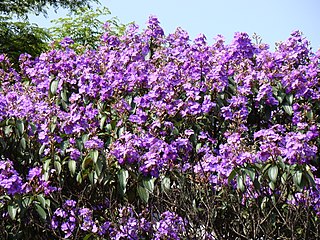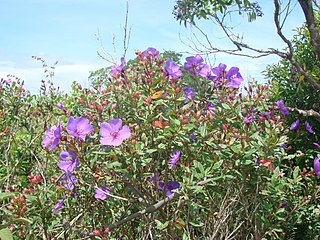
The Atlantic Forest is a South American forest that extends along the Atlantic coast of Brazil from Rio Grande do Norte state in the northeast to Rio Grande do Sul state in the south and inland as far as Paraguay and the Misiones Province of Argentina, where the region is known as Selva Misionera.

Tibouchina is a neotropical flowering plant genus in the family Melastomataceae. Species of this genus are subshrubs, shrubs or small trees and typically have purple flowers. They are native to Mexico, the Caribbean, and South America where they are found as far south as northern Argentina. Members of this genus are known as glory bushes, glory trees or princess flowers. The name Tibouchina is adapted from a Guianan indigenous name for a member of this genus. A systematic study in 2013 showed that as then circumscribed the genus was paraphyletic, and in 2019 the genus was split into a more narrowly circumscribed Tibouchina, two re-established genera Pleroma and Chaetogastra, and a new genus, Andesanthus.

The wildlife of Brazil comprises all naturally occurring animals, plants, and fungi in the South American country. Home to 60% of the Amazon Rainforest, which accounts for approximately one-tenth of all species in the world, Brazil is considered to have the greatest biodiversity of any country on the planet. It has the most known species of plants (60,000), freshwater fish (3,000), amphibians (1,188), snakes (430), insects (90,000) and mammals (775) It also ranks third on the list of countries with the most bird species (1,971) and the third with the most reptile species (848). The number of fungal species is unknown. Approximately two-thirds of all species worldwide are found in tropical areas, often coinciding with developing countries such as Brazil. Brazil is second only to Indonesia as the country with the most endemic species.

Pleroma elegans, synonym Tibouchina elegans, is an ornamental plant in the family Melastomataceae.

Syagrus pseudococos is a species of flowering plant in the family Arecaceae. It is found in tropical rainforest and on rocky outcrops in eastern Brazil along a coastal strip from extreme south of state of Bahia south through Espírito Santo, Rio de Janeiro to São Paulo.

Pleroma heteromallum, synonyms including Tibouchina grandifolia and Tibouchina heteromalla, known by the common name silverleafed princess flower in English, is a species of evergreen flowering plant in the family Melastomataceae. It is native to French Guiana, Bolivia and Brazil.

Tillandsia tenuifolia, the narrowleaf airplant, is a species in the genus Tillandsia. This species is widespread across much of South America and the Caribbean islands.
Fontes do Ipiranga Biological Reserve is a biological reserve in the Fontes do Ipiranga State Park in São Paulo State, Brazil.

Passiflora loefgrenii, the garlic passion fruit, is a passion flower first formally described in 1997 by Fabio Augusto Vitta. The plant is named after Albert Löfgren, the first known collector.

2,6-Dimethoxybenzoquinone (2,6-DMBQ) is a chemical compound, classified as a benzoquinone, that has been found in Rauvolfia vomitoria and in Tibouchina pulchra.

Syagrus cearensis is a natural palm endemic to Brazil.

Pleroma urvilleanum, synonym Tibouchina urvilleana, is a species of flowering plant in the family Melastomataceae, native to Brazil.

The Botanical Garden of São Paulo is a botanical garden in São Paulo, Brazil. The park spans a 164.45-hectare (406.4-acre) area in the Fontes do Ipiranga State Park, at the district of Água Funda, in São Paulo's South zone, next to São Paulo Zoo. It houses the state's Botanical Institute. It was founded, in its current location, in 1928, by the botanist Frederico Carlos Hoehne.

The Xitué Ecological Station is an ecological station in the state of São Paulo, Brazil. It protects a mountainous area of Atlantic Forest.

Pleroma mutabile, synonym Tibouchina mutabilis, is an evergreen pioneer tree with an open crown, native to the Brazilian Atlantic Forest, mainly at the Serra do Mar zone, in the states of São Paulo, Paraná, Rio de Janeiro, and Santa Catarina.

Pleroma granulosum, synonym Tibouchina granulosa, is a species of tree in the family Melastomataceae. It is also known as purple glory tree or princess flower. It is native to Bolivia and Brazil. Because its purple-flowers bloom for most of the year, this tree is often used for gardening in Brazil, where is known by the name quaresmeira.

Pleroma is a genus of flowering plant in the family Melastomataceae, native from Puerto Rico and the Leeward Islands to tropical South America.

Pleroma pereirae is a species of flowering plant in the family Melastomataceae, native to Brazil. It was first described in 1961 as Tibouchina pereirae.

Pleroma trichopodum is a species of flowering plant in the family Melastomataceae, native to south and southeastern Brazil. It was first described by Augustin de Candolle in 1828. One of its synonyms is Tibouchina trichopoda.



















